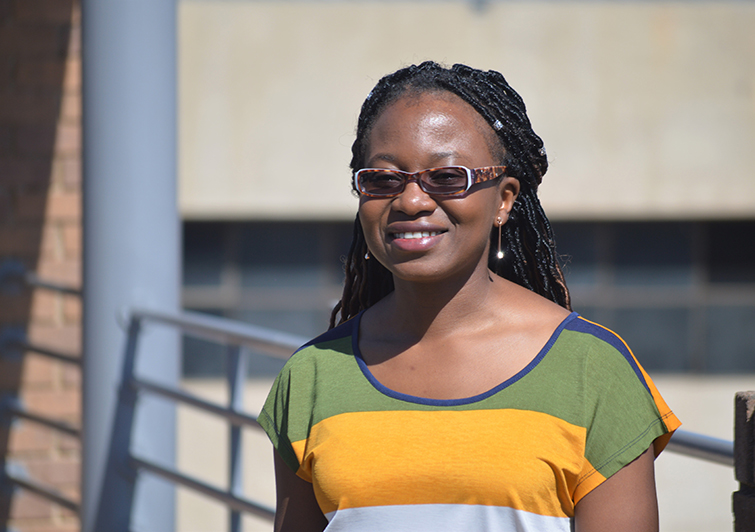Latest News Archive
Please select Category, Year, and then Month to display items
21 August 2019
|
Story Thabo Kessah
|
Photo Thabo Kessah
 Keafon Jumbam is gearing herself for the institutional Three Minute Thesis competition.
Keafon Jumbam is gearing herself for the institutional Three Minute Thesis competition.
Keafon Jumbam is a PhD candidate whose research on food and foxes has won her the first prize of R8 000 in the recent Faculty of Natural and Agricultural Sciences’ Postgraduate Flash Fact Competition. Her brief in the competition was to
summarise her research in three minutes, using only one static slide.“The competition started at departmental level on both campuses. The idea was that the best student in each department is then selected to go for the faculty-level competition on the Bloemfontein Campus. Summarising the entire research into three minutes is no easy feat, but a great way to gauge how well one has mastered your work,” she said.
Far-reaching research
“Thought-provoking presentations on research, ranging from technology to track academic progress, traditional medicine as alternatives to expensive prescriptions, and suggesting insects as food alternatives to curb hunger in this era of severe droughts and food shortages. The competition was tough, but it highlighted the level of research competitiveness on the Qwaqwa Campus. I hope that more students will join in such opportunities to build themselves up and to showcase our research output as Qwaqwa students,” added Jumbam from the
Department of Zoology and Entomology.
Institutional finals
Her next challenge is the institutional competition to be held on 23 August 2019, which could qualify her for the national competition.
Dying of consumption: Studying ‘othering’ and resistance in pop culture
2014-10-31
 |
The Centre for Africa Studies (CAS) at the UFS – under the project leadership of Prof Heidi Hudson (CAS Director) – conceptualised an interdisciplinary research project on representations of otherness and resistance.
This is in collaboration with UFS departments such as the Odeion School of Music, the Department of Drama and Theatre Arts, the Department of Fine Arts, the Jonathan Edwards Centre Africa and the Department of Afrikaans and Dutch, German and French.
In this project, Dr Stephanie Cawood from CAS leads a sub-project on the dynamics of pop culture and consumerism. Her research unpacks and critiques pop culture representations of othering and resistance by engaging with the othering rhetoric of conspicuous consumption as well as the subversive rhetoric or culture jamming at play in various South African youth subcultures.
Consumerism has become the institutional system in which we live our daily lives. Pop culture is the result when multinational corporations take aspects of culture and turn it into commodities with high market value. In pop culture and its manifestation, consumption, marketers and savvy advertising executives have realised long ago that othering and resistance are powerful tools to artificially create empty spaces in people’s lives that can only be filled through consuming.
“The scary thing is in my opinion that everyone has become a market segment, including very young children,” says Dr Cawood.
In his 1934 book, The Theory of the Leisure Class (TLC), Thorstein Veblen coined the term conspicuous consumption to describe the conduct of the nouveau riche. He contended that when people manage to meet their basic human requirements, any additional accumulation of wealth will no longer relate to function, but will be spent on ostentatious displays of conspicuous consumption or waste. Conspicuous consumption has evolved into invidious consumption where consumption is a mark of one’s superior social status and particularly aimed at provoking envy. The whole point is unashamed one-upmanship.
“Think of the izikhotane or skothane cultural phenomenon where young people engage in ritualised and ostentatious consumerist waste for social prestige. This is an excellent example of invidious consumption.
“Instead of striving to become good citizens, we have become good consumers and none are more vulnerable than our youth irrespective of cultural and ethnic differences”.